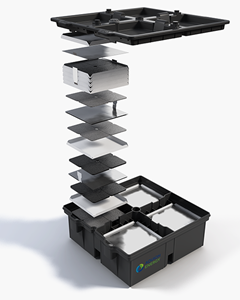Art-TechOnline
Sunday, October 4, 2015
The Future is Clear
Imagine a city that’s actually a vast solar energy harvesting system. A team of Michigan State University researchers has developed a technology that can turn transparent surfaces, from building windows to cell phones, into solar collecting surfaces – without obstructing the view.
Tuesday, October 21, 2014
Aquion Energy Unveils Next Generation of AHI Battery Technology Delivering a 40 Percent Increase in Energy
 |
| Inside an Aquion AHI Battery |
"We have been hard at work making the world's best long duration battery even better. The improved chemistry of the second generation Aqueous Hybrid Ion battery yields more energy, and will deliver more value for our customers," said Scott A. Pearson, CEO of Aquion Energy. "We are unveiling the new technology at Solar Power International because Aquion's unmatched long duration batteries enable optimal self-consumption of distributed solar generation and ease the burden of intermittent renewable energy on the grid. These two applications are the key to unlocking broad adoption of clean solar electricity as a mainstream energy source." - See more at:
Aquion Energy Unveils Next Generation of AHI Battery Technology Delivering a 40 Percent Increase in Energy
Thursday, March 6, 2014
US researchers propose Earth's infrared radiation as renewable energy source - SCI_TECH - Globaltimes.cn
Infrared energy emitted from the Earth into space may be potentially harnessed as a renewable energy source in the future, US researchers said Monday.
Physicists at the Harvard School of Engineering and Applied Sciences (SEAS) proposed a device that would resemble a photovoltaic solar panel. But instead of capturing incoming visible light, it would generate electric power by harvesting energy from Earth's infrared emissions into outer space.
"The energy flow from earth to outer space provides a hitherto neglected opportunity to generate a potentially enormous amount of renewable energy," the researchers reported in the US journal Proceedings of the National Academy of Sciences.
"The technology does not yet exist to siphon renewable energy out of this flow, but we argue that it is possible to make a device that does exactly that."
The researchers proposed two possible designs for an emissive energy harvester (EEH) to harness such infrared emissions.
The first design, a thermal EEH, would generate electricity by drawing the heat of surface ambient air through a cold plate that could radiate the energy into the atmosphere, with the flow of heat generating work.
Read the full story at:
SCI_TECH - Globaltimes.cn
Physicists at the Harvard School of Engineering and Applied Sciences (SEAS) proposed a device that would resemble a photovoltaic solar panel. But instead of capturing incoming visible light, it would generate electric power by harvesting energy from Earth's infrared emissions into outer space.
"The energy flow from earth to outer space provides a hitherto neglected opportunity to generate a potentially enormous amount of renewable energy," the researchers reported in the US journal Proceedings of the National Academy of Sciences.
"The technology does not yet exist to siphon renewable energy out of this flow, but we argue that it is possible to make a device that does exactly that."
The researchers proposed two possible designs for an emissive energy harvester (EEH) to harness such infrared emissions.
The first design, a thermal EEH, would generate electricity by drawing the heat of surface ambient air through a cold plate that could radiate the energy into the atmosphere, with the flow of heat generating work.
Read the full story at:
SCI_TECH - Globaltimes.cn
Wednesday, September 4, 2013
Ion-Conducting Polymer Improves Solar Cell Performance
by The Daily Fusion
Drawing their inspiration from photosynthesis, dye-sensitized solar cells offer the promise of low-cost solar photovoltaics and—when coupled with catalysts—even the possibility of generating hydrogen and oxygen, just like plants. Researchers at KTH Royal Institute of Technology have found a way to make dye-sensitized solar cells more energy-efficient and longer-lasting.
read full article:
Ion-Conducting Polymer Improves Solar Cell Performance | The Daily Fusion
DSSC panel is tested in the laboratory at the School of Chemical Science and Engineering. (Photo: David Callahan)
Drawing their inspiration from photosynthesis, dye-sensitized solar cells offer the promise of low-cost solar photovoltaics and—when coupled with catalysts—even the possibility of generating hydrogen and oxygen, just like plants. Researchers at KTH Royal Institute of Technology have found a way to make dye-sensitized solar cells more energy-efficient and longer-lasting.
A research team that included James Gardner, Assistant Professor of Photoelectrochemistry at KTH, reported the success of a new quasi-liquid, polymer-based electrolyte that increases a dye-sensitized solar cell’s voltage and current, and lowers resistance between its electrodes.
The study highlights the advantages of speeding up the movement of oxidized electrolytes in a dye-sensitized solar cell, or DSSC. Also on the team from KTH were Lars Kloo, Professor of Inorganic Chemistry and researcher Muthuraaman Bhagavathi Achari.
“We now have clear evidence that by adding the ion-conducting polymer to the solar cell’s cobalt redox electrolyte, the transport of oxidized electrolytes is greatly enhanced,” Gardner says. “The fast transport increases solar cell efficiency by 20 percent.”
read full article:
Ion-Conducting Polymer Improves Solar Cell Performance | The Daily Fusion
Subscribe to:
Posts (Atom)